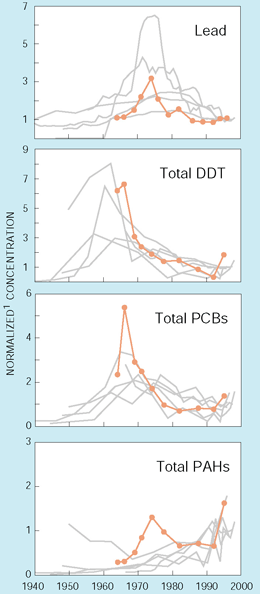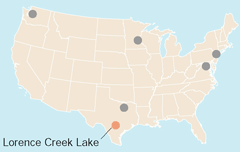MAJOR FINDINGS
Stream Quality Is Affected Most by Urban Activities
Chemical and biological indicators in monitored streams in key land-use settings in the Study Unit (fig. 6) show that stream-quality degradation tends to be associated with urban land to a greater degree than with agricultural land or rangeland. With a few exceptions, pesticides, VOCs, and trace elements were either not detected or detected at concentrations below levels of concern for human health or aquatic life in all monitored streams.
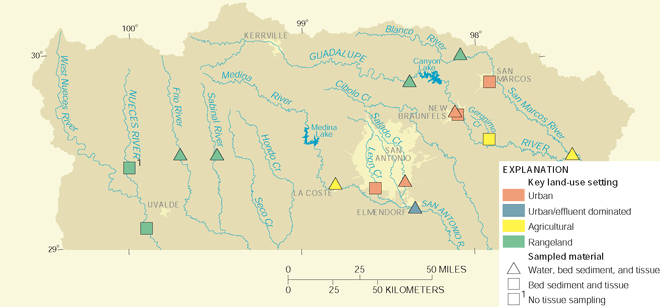 |
| Figure 6. Stream-water sampling in key land-use settings in the Study Unit was done at 9 sites, bed-sediment sampling at 15 sites, and fish-tissue sampling at 14 sites. |
Nutrient Concentrations Increased as a Result of Wastewater-Treatment Plant Discharges
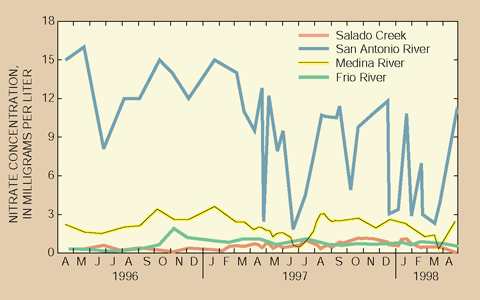 |
| Figure 7. Nutrient concentrations were consistently higher in streams influenced by urban wastewater-treatment plant discharge (San Antonio River) and agricultural runoff (Medina River) than in an urban stream (Salado Creek) or a rangeland stream (Frio River). Greater rainfall and streamflow during 1997 and early 1998 diluted nitrate concentrations associated with wastewater-treatment plant discharge in the San Antonio River at Elmendorf. |
Discharges from wastewater treatment plants had the greatest effect on nutrient concentrations of any identifiable source in the Study Unit [6]. Nitrate concentrations were appreciably higher in an urban stream downstream from four wastewater treatment plants (San Antonio River at Elmendorf) than in streams in other land-use settings (fig. 7). Nitrate concentrations in the San Antonio River at Elmendorf generally increased as the percentage of wastewater-treatment plant discharge (effluent) in streamflow increased (fig. 8). Although the San Antonio River historically has not been a source of drinking water, the median nitrate concentration at Elmendorf (11 milligrams per liter [mg/L]) exceeded the U.S. Environmental Protection Agency (USEPA) maximum contaminant level (MCL) for drinking water (10 mg/L). No aquatic-life guideline for nitrate has been established. The flow-weighted mean nitrate concentration at Elmendorf, 5.8 mg/L, was about the 90th percentile among 372 NAWQA stream sites nationwide.
 |
| Figure 8. Differences in rainfall-runoff relations with flow in the San Antonio River at Elmendorf account for variability in the dilution of wastewater-treatment plant discharge. Concentrations of nitrate in the river increased appreciably with the percentage of wastewater-treatment plant discharge in the streamflow. |
Ammonia at sufficient concentrations, which vary with water temperature and acidity [7], can be toxic to fish. Median ammonia concentration at Elmendorf was 0.1 mg/L, the same as the estimated national background concentration in streams essentially unaffected by human activities [8]. Modern treatment plants effectively remove ammonia from wastewater by converting it to nitrate.
Land use had less effect on nutrient concentrations than proximity to wastewater treatment plants. The median nitrate concentration in an urban stream not affected by wastewater-treatment plant discharge (Salado Creek at San Antonio) was 0.56 mg/L, about the same as the estimated national background nitrate concentration (0.6 mg/L) in streams essentially unaffected by human activities [8]. The median nitrate concentration in an agricultural (cropland) stream (Medina River at La Coste) was 2.0 mg/L, higher than that of Salado Creek and showing the effect of runoff containing nitrate from fertilizers. The median is typical of median nitrate concentrations in surface water draining agricultural areas in selected NAWQA Study Units nationwide [8]. Median nitrate concentrations in four rangeland streams (Frio, Sabinal, Guadalupe, and Blanco Rivers) were near background levels (0.34 to 0.77 mg/L).
Nitrate concentrations vary over time in response to hydrologic conditions, wastewater-treatment plant discharges, plant and algal uptake, and timing of fertilizer application. However, no seasonal pattern in concentrations associated with any land-use setting was evident (fig. 7).
Total phosphorus concentrations also were highest in the San Antonio River at Elmendorf. The median total phosphorus concentration was 1.6 mg/L, and all concentrations were greater than the USEPA goal of 0.1 mg/L to control nuisance algae and aquatic plant growth. The flow-weighted mean total phosphorus concentration at Elmendorf, 1.2 mg/L, was about the 98th percentile among 372 NAWQA stream sites nationwide. The median total phosphorus concentration in Salado Creek at San Antonio, the urban stream not affected by wastewater-treatment plant discharge, was 0.066 mg/L, and individual concentrations commonly exceeded the USEPA goal of 0.1 mg/L. The median total phosphorus concentration for the Medina River at La Coste, the agricultural stream, was 0.030 mg/L; and the median concentration for each of the four rangeland streams was less than 0.010 mg/L, the minimum reporting level. Total phosphorus concentrations in all streams exceeded the USEPA goal during stormflows. Higher phosphorus concentrations during stormflows is consistent with the adherence of phosphorus to sediment particles and the increase in suspended sediment concentrations during stormflows.
| Nutrients in Water |
|
Nitrogen (primarily dissolved nitrate) and phosphorus (primarily dissolved phosphates and organic phosphorus in streams and orthophosphate in ground water) are essential to the health of plants and animals. Elevated concentrations of these nutrients in water, however, can cause problems. Too much nitrate in drinking water can reduce oxygen concentrations in the blood of infants to dangerously low levels. Excessive nitrate and phosphorus concentrations in surface water can cause nuisance algae and plant growth, which in turn can adversely affect aquatic ecosystems and water-related recreational activities. Nitrogen and phosphorus occur naturally in water, but natural concentrations are increased by the introduction of fertilizers, manure, or treated sewage effluent into the water. |
More Pesticides—at Generally Higher Concentrations—Were Associated with Urban Land Use
More pesticides and their breakdown products (hereinafter, pesticides) were detected in Salado Creek at San Antonio (25 of 83 analyzed) than in the San Antonio River at Elmendorf downstream from the wastewater treatment plants (18 of 83) and the Medina River at La Coste (15 of 83) [6]. Samples from rangeland streams were not analyzed for pesticides. The maximum concentrations of 7 of the 10 pesticides detected in all three streams occurred in Salado Creek at San Antonio. In all three streams, some pesticide concentrations increased in the spring, which is consistent with the time of year for application.
| Pesticides in Streams—How Toxic to Aquatic Life? |
|
According to the Extension Toxicology Network [9], the insecticide carbaryl, a general-use pesticide, is moderately toxic to aquatic organisms. The insecticide diazinon, some formulations of which are classified as restricted use (use by certified applicators only), is highly toxic to fish. The insecticide gamma-HCH, some formulations of which are classified as restricted use, is highly to very highly toxic to aquatic organisms. The insecticide malathion, a general-use pesticide, has a wide range of toxicities to aquatic organisms. DDE is a breakdown product of the insecticide DDT, which was banned for use in the United States in 1972. DDE has similar chemical and physical properties to DDT, which is very highly toxic to fish and to many aquatic invertebrate species. The herbicide tebuthiuron, a general-use pesticide, is slightly toxic to practically non-toxic to aquatic organisms. Atrazine is a restricted-use pesticide (home use exempted from restrictions) commonly used to kill broadleaf weeds. Atrazine is the most widely used herbicide in Texas corn and grain sorghum production [10] and the most widely used pesticide in the United States [11]. The Extension Toxicology Network [9] classifies atrazine as slightly toxic to aquatic organisms. No aquatic-life guideline has been established for the atrazine breakdown product deethylatrazine. The herbicide prometon, a general-use pesticide, has been shown in toxicological studies on selected fish species to have very low toxicity [12]. The herbicide simazine, also a general-use pesticide, is slightly toxic to practically non-toxic to aquatic organisms [9]; and the herbicide diuron, another general-use pesticide, is moderately toxic to fish and highly toxic to aquatic invertebrates [9]. |
No concentration of a pesticide for which a drinking-water standard has been established (25 of 31 pesticides detected) exceeded that standard in any of the three streams. However, aquatic-life guidelines (established for 17 of 31 pesticides detected) were exceeded in at least one sample for 5 pesticides in Salado Creek at San Antonio, 3 insecticides in the San Antonio River at Elmendorf, and 1 insecticide in the Medina River at La Coste (table 1).
| Table 1. Pesticides and VOCs in stream water for which at least one sample exceeded an aquatic-life guideline [I, insecticide; H, herbicide; VOC, volatile organic compound] |
||||
| Compound |
Type |
Number of exceedances / samples |
||
|---|---|---|---|---|
|
Salado Creek |
San Antonio River |
Medina River |
||
| Carbaryl |
I |
1 / 35 |
2 / 26 |
0 / 32 |
| Diazinon |
I |
11 / 35 |
3 / 26 |
0 / 32 |
| Gamma-HCH |
I |
0 / 35 |
12 / 26 |
0 / 32 |
| Malathion |
I |
1 / 35 |
0 / 26 |
0 / 32 |
| p,p' -DDE |
I |
4 / 35 |
0 / 26 |
2 / 32 |
| Tebuthiuron |
H |
1 / 35 |
0 / 26 |
0 / 32 |
| Trichloromethane |
VOC |
0 / 22 |
8 / 13 |
0 / 7 |
The most frequently detected pesticides in all three streams were atrazine, deethylatrazine, and prometon (fig. 9). Atrazine was detected in all of the samples from each of the three streams.
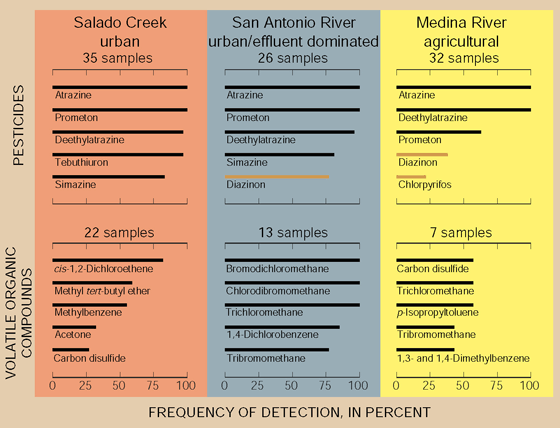 |
| Figure 9. Pesticides and VOCs were detected more frequently in urban streams than agricultural streams. The five pesticides and VOCs most frequently detected in stream water are shown. More herbicides than insecticides (shaded brown) were detected. |
The number of pesticides and the most frequently detected pesticides in each stream change when frequency of detection is based on a common concentration of 0.05 microgram per liter (µg/L). (See box, p. 9.) In Salado Creek at San Antonio, 13 pesticides were detected on the basis of the common concentration (compared with 25 detected without regard to a common concentration). The five most frequently detected pesticides and their detection frequencies based on the common concentration were Tebuthiuron 91 percent, Atrazine 46 percent, Diazinon 46 percent, Diuron 37 percent, and Carbaryl 31 percent.
In the San Antonio River at Elmendorf, only 5 pesticides were detected on the basis of the common concentration (compared with 18). The five detected and their detection frequencies were Atrazine 46 percent, Diazinon 27 percent, Carbaryl 19 percent, Tebuthiuron 19 percent, and Diuron 12 percent.
In the Medina River at La Coste, 5 pesticides also were detected on the basis of the common concentration (compared with 15). Detection frequencies of all 5 pesticides based on the common concentration were less than 10 percent.
The number of pesticides detected and, in general, the frequencies of detection based on a common concentration of 0.05 µg/L are substantially less than those not based on a common concentration. This result underscores the fact that the majority of pesticide detections in stream water represent extremely low concentrations. Less than 0.05 µg/L means less than 1 part contaminant per 20 billion parts water, which is about the same concentration as an aspirin tablet dissolved in an olympic-size swimming pool.
All of the surface-water samples contained more than one pesticide, which is consistent with national NAWQA findings that show pesticides commonly occur in mixtures of several compounds [13]. Drinking-water standards for combinations of pesticides have not been established, and very little is known about the effects of mixtures of pesticides on aquatic life.
Most Volatile Organic Compound Concentrations Were Low Relative to Standards and Guidelines
The most VOCs (33 of 86 analyzed) were detected in the San Antonio River at Elmendorf. Twenty-one VOCs were detected in Salado Creek at San Antonio. As was the case with pesticide detections, the fewest VOC detections (15) were in the Medina River at La Coste [6]. The maximum concentrations of 7 of the 10 VOCs detected in all three streams were from the San Antonio River at Elmendorf. No samples from rangeland streams were analyzed for VOCs. Of the 20 VOCs detected for which drinking-water standards and (or) aquatic-life guidelines have been established, one VOC—trichloromethane— exceeded the Canadian water-quality guideline for the protection of aquatic life [14] in 8 of 13 samples in the San Antonio River at Elmendorf (table 1). Trichloromethane is moderately toxic to aquatic life [15], but it is not persistent in surface water; one-half of it will have evaporated after several days. No other VOC concentrations in any of the three streams approached the levels of concern for the protection of human health or aquatic life.
Four of the 5 VOCs most frequently detected in the San Antonio River at Elmendorf (bromodichloromethane, chlorodibromomethane, trichloromethane, and tribromomethane) (fig. 9), are by-products of water chlorination. The presence of these trihalomethane compounds is consistent with the fact that a major part of the flow of the river was wastewater-treatment plant discharge. On the basis of a common concentration of 0.1 µg/L, only 5 VOCs were detected (compared with 33 detected without regard to a common concentration). The same four trihalomethanes were detected at essentially the same frequencies as those detected without regard to a common concentration (fig. 9). The fifth, methylbenzene, was detected in 31 percent of the samples.
Four of the 5 VOCs most frequently detected in Salado Creek at San Antonio (cis-1,2-dichloroethene, methylbenzene, acetone, and carbon disulfide) (fig. 9) are industrial chemicals with a variety of uses. They probably entered the stream in urban runoff. The fifth VOC most frequently detected (methyl tert-butyl ether [MTBE]) was 1 of 3 VOCs detected on the basis of a common concentration of 0.1 µg/L. MTBE was the only one of the three with a detection frequency (50 percent) greater than 10 percent. MTBE is a gasoline additive used primarily to reduce air pollution and has received recent publicity because of its potential to contaminate ground water. Although the use of MTBE in gasoline in the area has not been mandatory, it likely has been in some of the gasoline supplied to service stations and subsequently entered the environment during refueling at service stations or from engine exhaust, leaking storage tanks, or spills.
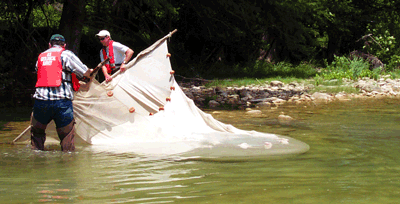 |
| Fish for tissue analysis and community status assessment were collected by seining (shown above in the Blanco River near Wimberley) and by electrofishing. |
The five VOCs most frequently detected in the Medina River at La Coste (fig. 9) are hard to associate with a specific agricultural use. None of the five were detected on the basis of a common concentration of 0.1 µg/L. Two other VOCs, benzene and methylbenzene, were detected on the basis of the common concentration (compared with 15). The frequency of detection for both was 14 percent.
As with pesticides in stream water, the substantially smaller number of VOCs detected and, in general, the reduced frequencies of detection based on a common concentration show that the majority of VOC concentrations were extremely low—less than 1 part contaminant per 10 billion parts water.
Persistent Contaminants That Accumulate in Sediment and Fish Tissue Were Most Prevalent in Urban Streams
The occurrence of environmentally persistent organochlorine compounds (organochlorine insecticides and polychlorinated biphenols [PCB]), semivolatile organic compounds (SVOC) including polycyclic aromatic hydrocarbons (PAH), and trace elements (primarily metals) was assessed by measuring their concentrations in stream sediment and fish and clam tissue in key land-use settings. (Urban and urban/effluent dominated samples were grouped together as urban.)
Sediment samples from 15 sites (fig. 6) were analyzed for 32 organochlorine pesticides, total PCBs, and 63 SVOCs. The greatest number of contaminants detected, and generally the highest concentrations (table 2), occurred in urban stream sediment. An average of 26 contaminants per site were found at 6 urban sites. An average of 10 contaminants per site were found at 3 agricultural sites; and an average of 8 contaminants per site were found at 6 rangeland sites.
The total organochlorine pesticide concentrations (sum of concentrations of all pesticides detected at each site) in some urban sediment samples were among the highest of 836 NAWQA stream sites nationwide. Total concentrations at 3 of the 6 urban sites ranked in the top 12 percent. In contrast, no pesticides were detected in sediment from 2 of the 3 agricultural streams, and none were detected in sediment from any of the 6 rangeland sites. PCBs were not detected in any stream-sediment samples.
The stream-sediment samples also were analyzed for 44 trace elements. Although the frequencies of detection were similar among urban, agricultural, and rangeland sites (23 to 28 per site), the concentrations generally were highest in urban sediment (table 2).
For the 27 organochlorine pesticides and total PCBs analyzed in wholebody and carcass (wholebody without liver) fish tissue from nine sites, the greatest number of contaminants, and generally the highest concentrations (table 2), also were found in urban samples. An average of 5 contaminants per sample were found in 7 urban fish-tissue samples; an average of 2 contaminants per sample were found in 10 agricultural fish-tissue samples; and an average of 2 contaminants per sample were found in 4 rangeland fish-tissue samples. The fish-tissue samples were composites from 3 to 9 fish of the same species, typically common carp (Cyprinus carpio).
| Table 2. Concentrations of contaminants in urban, agricultural, and rangeland stream sediment and fish and clam tissue [Concentrations are average of
samples from number of streams listed] |
|||
| Selected organochlorine
pesticides and PAHs in sediment |
|||
|
|
Urban |
Agricultural |
Rangeland |
|---|---|---|---|
| Chlordane |
7.1 |
<1.0 |
<1.0 |
| Total DDT |
6.3 |
.64 |
<1.0 |
| Total PAHs |
1,327 |
150 |
90 |
| Selected trace elements
in sediment |
|||
|
|
Urban |
Agricultural |
Rangeland |
| Arsenic |
6.1 |
4.0 |
1.7 |
| Cadmium |
.5 |
.2 |
.3 |
| Chromium |
49.5 |
40.3 |
17.5 |
| Copper |
17.7 |
9.3 |
4.5 |
| Lead |
40.8 |
15.7 |
8.2 |
| Mercury |
.1 |
.01 |
.1 |
| Selenium |
.6 |
.8 |
.9 |
| Zinc |
93.5 |
60.3 |
74.2 |
| Selected organochlorine
compounds in wholebody and carcass fish tissue |
|||
|
|
Urban |
Agricultural |
Rangeland |
|
Chlordane |
43 |
7 |
4 |
| Total DDT |
110 |
26 |
28 |
| Total PCBs |
286 |
60 |
16 |
| Selected trace elements
in clam tissue |
|||
|
|
Urban |
Agricultural |
Rangeland |
| Arsenic |
5.9 |
5.5 |
4.4 |
| Cadmium |
3.8 |
.5 |
.4 |
| Chromium |
3.9 |
2.6 |
1.8 |
| Copper |
60 |
31.0 |
21.8 |
|
Lead |
3.3 |
1.7 |
.5 |
| Mercury |
.2 |
.03 |
.1 |
| Selenium |
5.4 |
7.3 |
6.7 |
| Zinc |
277 |
143 |
164 |
The total organochlorine pesticide concentrations in urban wholebody and carcass fish-tissue samples ranked in the middle-to-high range among concentrations in wholebody tissue from 505 NAWQA sites nationwide. Three of the 7 urban sample concentrations were in the top 25 percent. As with total organochlorine pesticide concentrations in sediment, concentrations in agricultural and rangeland fish-tissue samples generally were lower than those in urban samples. Only 2 of the 10 agricultural samples and none of the 4 rangeland samples contained total organochlorine pesticide concentrations in the upper 50 percent of concentrations nationwide.
Total PCB concentrations in wholebody and carcass fish-tissue samples generally followed the same pattern. Concentrations were in the top 15 percent of wholebody PCB concentrations nationwide in 4 of the 7 urban samples, 1 of the 10 agricultural samples, and none of the 4 rangeland samples.
In clam (Corbicula) tissue from 12 sites, the concentrations of trace elements generally were highest in the samples from urban sites (table 2). In fish-liver tissue from nine sites, however, no clear association between trace element concentration and watershed land use was evident.
At some sites, concentrations of some sediment contaminants exceeded the Canadian sediment guidelines for the protection of aquatic life [17]. The guidelines are termed “probable effects levels” (PEL). The PEL is the concentration above which adverse effects on aquatic life are predicted to occur frequently. PELs have been established for 18 of the 43 organochlorine compounds and SVOCs and 8 of the 28 trace elements detected in sediment. In one each of 4 urban sediment samples, DDT, DDE, chlordane, and lead concentrations exceeded the respective PEL; in 1 rangeland sediment sample, the mercury concentration exceeded the PEL.
Guidelines to protect fish-eating wildlife (for the State of New York) [18] have been established for 8 of the 10 organochlorine compounds detected in wholebody and carcass fish tissue but not for the 19 trace elements detected in clam and fish-liver tissue. Total PCB concentrations in 6 of the 7 urban fish-tissue samples and 2 of the 10 agricultural fish-tissue samples exceeded the guideline for PCBs. The guideline for total DDT was exceeded in 1 of the 7 urban fish-tissue samples.
Urban development in watersheds is leaving similar marks on water quality nationwide. Changes in water quality over time as watersheds become more urban are recorded in the successive layers of bottom sediment in lakes and reservoirs (hereinafter, lakes). Soil and debris, and any attached contaminants, carried by runoff to the lakes settle to the bottom. By analyzing short sections of sediment cores (vertical tubes of mud) extracted from lake bottoms across the country, the USGS has been documenting changes in water quality as the watersheds become more developed. Lorence Creek Lake, a small suburban lake in a rapidly urbanizing area in northern San Antonio, fits the pattern observed nationally. Trends in selected contaminants from Lorence Creek Lake sediment [16] generally match those from other lakes in watersheds in different parts of the country that have undergone rapid urban development in recent years. Lead concentrations generally peaked in the mid-1970s and declined appreciably as unleaded gasoline and lower lead content in other products became widespread. Total DDT concentrations generally followed the historical use of DDT in the United States, which peaked from the late 1950s to the mid-1960s and then declined substantially. DDT was banned in 1972. Total PCB concentrations generally peaked in the mid-1960s and declined in the 1970s, reflecting peak production and subsequent regulation of PCBs in the United States. Total PAH concentrations generally have increased substantially since about 1970. PAHs result from the burning of hydrocarbons and other organic material. The lower concentrations in Lorence Creek Lake sediment in the 1980s are thought to be due to washed-in soil from subsurface layers (older and thus low in PAH concentration) associated with major highway construction adjacent to the lake.
1 The graphed contaminant concentrations are “normalized” values. That is, the concentrations down each core were divided by the mean concentration of the top three samples in each core. This allows very different concentrations to be graphed together to show similarity in trends. |
Floodflows, Non-Native Species Can Affect Biological Community Status
Intense rainstorms on terrain conducive to rapid runoff result in frequent floodflows in the Study Unit. In June 1997, about a month before biological samples were collected, severe flooding on the Frio and Sabinal Rivers affected the biological communities, particularly the invertebrates. Estimated recurrence intervals for the peak floodflows at the sampling sites on the Frio and Sabinal Rivers were 15 and 90 years, respectively [19]. For both rivers, the invertebrate communities were more degraded in 1997 than in 1996 and 1998 during considerably drier conditions. Changes in the percentages of certain algae reflected less siltation and reduced nutrient concentrations after scouring floodflows. The fish communities were not noticeably affected by the flooding.
More than 30 non-native aquatic species, many of tropical origin, are known to exist in the Study Unit [20, table 5]. Non-native aquatic species are considered a threat to native species [21]. However, the findings of this study show that native fish species remain dominant at the locations sampled. The redbreast sunfish (Lepomis auritus), originally introduced in Texas as a game fish, was the most common non-native fish species, particularly in the Blanco River where clear-flowing water favors this species.
| Table of Contents || Previous Section || Next Section || Glossary U.S. Geological Survey Circular 1212 Suggested citation:
|


